Make It Monday: Manual Communication Boards with Core Vocabulary
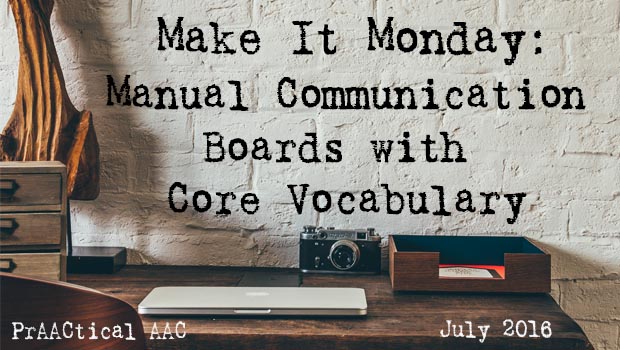
Welcome to Make It Monday, a series in which we hope to inspire your team to create communication boards and instructional materials for students who need or already use core vocabulary. In the first post, Getting Ready for a Core Vocabulary Journey, we talked about getting set up to make materials for expressive and receptive language use. Today, we get into making manual communication boards (MCBs).
About Manual Communication Boards
The term manual communication board refers to a ‘no-tech’ AAC support that students can use to express themselves. Typically printed on paper and laminated, most MCBs have grids of words organized by part of speech (e.g., verbs in one area, adjectives in another). MCBs that are designed for use in a particular activity, such as doing an art project or participating in Circle Time, are called activity-based communication displays, or ABCDs.
ABCDs were very popular in the early days of AAC, but are used less frequently these days because of their significant drawbacks. You can read more about that here. In the past two years, clinicians and educators who make, use, and share ABCDs have improved them by using quite a lot of core vocabulary, a nice step in the right direction. Nevertheless, the AAC field more or less moved away from those and toward MCBs with a richer set of core vocabulary for two key reasons. One is to provide more stability for the learner. The location of words on ABCDs changes from board to board, which is detrimental to the learning process. A second reason relates to generalization and functional use. Lessons with ABCDs often look great to an observer because the student is engaged, participating, and expressing him/herself. What the observer might not realize, though, is that after the activity is over, the student loses access to the ABCD and no longer has a functional means of communication.
Janie, for example, used an ABCD for art to make a thank you card and picked the glitter she wanted from the column of colors on the right side of the board. Today, she got excited about a book they were reading, and wanted to say something about the orange shell in A House for Hermit Crab using the ABCD that her teacher prepared as a companion for that book. She looked for colors on the right side (where they were in the art ABCD), but had no luck. The ABCD for the book focused on the characters, actions, and settings for the story. No color words were included because colors aren’t the most salient elements of the story. When Janie got frustrated and became agitated, the adults attributed it to the presence of a substitute aide, which was a plausible idea but not the actual antecedent to her problem behavior. Janie had an idea, knew what she wanted to say, and was motivated to express it, but got stymied by the limitations of the AAC tools we had chosen.
In reality, we’re not very good at predicting what exactly people want to talk about it in the context of a specific activity. When I observed some students with developmental disabilities playing a board game, for example, the conversation included comments about cars, discussions about weekend activities, and questions about future events. Sure, there was ‘game talk,’ like “Your turn” and “Hurry up.” But the ‘real’ conversation wasn’t centered on the game at all. You probably have had similar experiences with your own students. Examples like these give us all food for thought. Shouldn’t the AAC tools we choose allow students to express the things THEY want to talk about?
So…If you’re still using ABCDs, here’s the main question to ask yourself: How will this help my student after the lesson is over? If you’re feeling confident that the tools you’ve provided allow them to communicate effectively outside of therapy and instruction, then you may not need to make many adjustments. If not, however, the next question is this: What are my next steps to build a more effective communication system?
To paraphrase Maya Angelou, when we know better, we do better. Nowadays, we know that it makes more sense to create MCBs that have a stable layout of core vocabulary and supplement with activity-specific words, as needed.
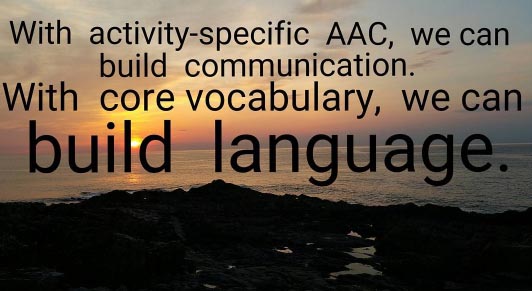
Which Core Words?
There are lots of ‘right ways’ to pick the core vocabulary that will suit your learners’ needs. Among other things, you can:
- Consult one of the many core vocabulary lists that are available (see our post with a list of core word lists)
- Use the core vocabulary that populates an AAC device or app that your students use (or may use in the future)
- Review some of the pre-made core vocabulary materials that are available to see which one best fits your students’ needs (Spoiler alert: We’ve linked to some at the end of the post)
Layout: Where to Put Each Word
Now that we’ve made a decision on what type of symbol to use (last week’s post) and what core words to use, it’s time to start thinking about the layout of the core communication boards we’ll be making. Again, there are lots of options but it’s best to plan with the end in sight. Knowing where you want to end up can help you avoid time-consuming mistakes. For example, if the SLP designs a core board based on Janie’s current level of performance, it might have 6 columns with 5 rows (30 words in total), neatly organized with the Fitzgerald Key. That might work well for a short time, but what about next month when Janie is ready for 5 new words? No room for those, unless we mess up the layout which was neatly organized to maximize learning and sentence-building. Not a good idea! So, that means she’ll have to redo the design of the board (time-consuming) and the student has to UN-learn the location of words on the original MCB, and learn their new locations in the updated board. And…she’ll have to do all of this again in another 6 weeks when Janie needs 5 more words added to her board. Not fun!
A better approach is to think ahead to the words the student will need by the end of the year, and use that as your starting point to plan the MCBs. It’s easy to look at that full, then mask some of the words to create intermediate and easy versions. Start with the end in mind, and work backwards from there. You’ll save yourself time, reduce frustration, and improve student outcomes, too.
Here’s an example from some wonderful professionals in the Florida panhandle. At the end of the year, this team expected the students to be using this version (with support).
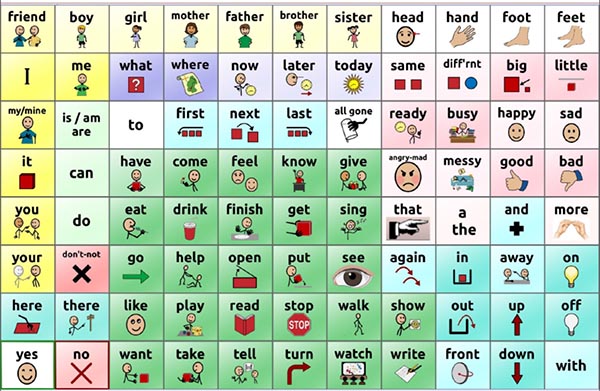
With that in mind, they made intermediate and beginner versions that were used earlier in the school year.
Beginning Version
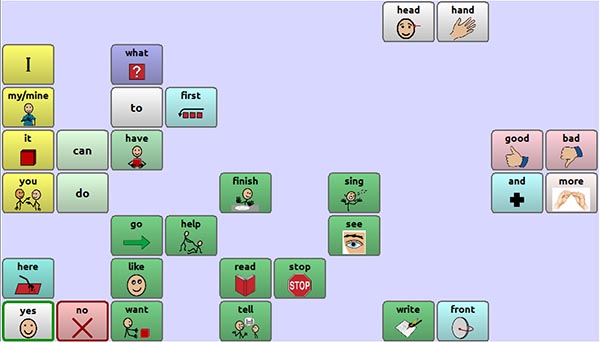
Intermediate Version
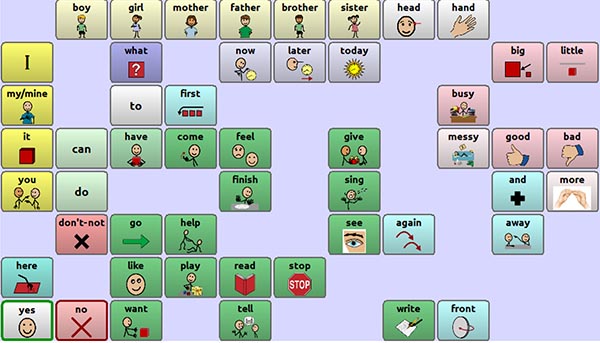
Don’t you love the power of a well-conceived plan?! In theory, yes! But in prAACtical terms, when we already purchased or created communication boards for specific activities, printed, and laminated them, it can be discouraging to realize that a different solution is called for.
“But I already have several communication boards for activities we do in therapy (or in the classroom). I’ve used them all last year and the kids loved them! Can’t I use those instead of making new core boards?”
It depends. Here are some questions to consider in making that decision.
- Are the symbols consistent with those on the student’s AAC device/app? Some students struggle when words are represented one way on an ABCD and a different way on the AAC app or SGD. If you cover the text and show the symbol to a naive partner, will he/she know what it is supposed to represent? If not, our students are probably going to have that same problem.
- How will my student communicate these words after the lesson is over? Unless the student has access to these words throughout the day, we haven’t really given them a means of functional communication.
- What if my student wants to talk about something not represented on the ABCD? We sometimes assume that students will stick to the topic at hand while engaged in an activity but that often isn’t the case. While making a recipe in a Life Skills class, speaking students were observed to make comments about things they cooked at home, people with whom they cooked, favorite dishes, and mishaps from prior cooking experiences. The majority of words that they used in these discussions were core words, and only a few of them were on the ABCD. Like these students, Janie, and the students playing a board game, your student probably wants to say things that none of use could predict. Our goal is to give them the kinds of words so that they can always do that.
“Okay, I’m ready. Let’s make some core boards!”
Sounds great! If the information we’ve covered so far has inspired you to make a MCB rich in core vocabulary, good for you!
Of course, you can make yours ‘from scratch’ using software, online subscription services, or some of the tools I’ve already mentioned.
Looking to download some pre-made core boards? Here are some that may be of interest.
- 42 and 60-location boards based on WordPower (Thanks, Nancy Inman and Saltillo!)
- 45-location board using PCS (Thanks, Region 13 Service Center!)
- 48-location board with high-contrast PCS (Thank you, Rachael Langley!)
- 36-location board poster (Thanks to the team at the Center on Literacy and Disability Studies!)
A few last things before you print: Core boards get used a lot, so consider printing on cardstock or a heavy bond paper and using thicker laminating film for added durability. Also: be sure to leave an extra row or two of blank cells at the top so we can put in some additional symbols later on. More about that, and other things that may change how you print and assemble your core word board, in a future post. Thanks for joining us on the Core Vocabulary Journey. See you next week for another Make It Monday post!
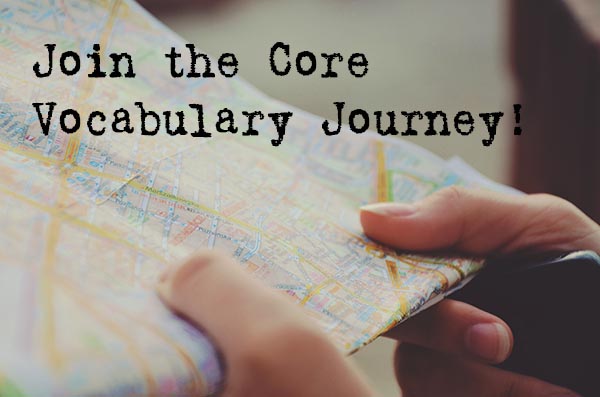
Filed under: Featured Posts, PrAACtical Thinking
Tagged With: communication book, core vocabulary
This post was written by Carole Zangari
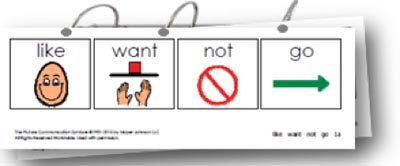


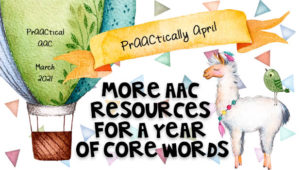
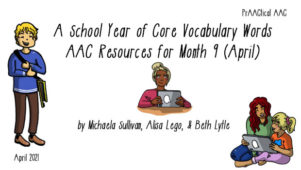

11 Comments
Love this. Thanks for the updated list of some of the free available core words. As always this post is so well written in a format that makes sense to all people.
Thanks for those kind words, Jess. Transitioning from activity-based AAC, choicemaking displays, and request-oriented communication materials can be VERY overwhelming. Even making the materials to get ready for implementation can be a daunting process. I hope this makes the process a little smoother for some of our prAACtical friends.
Excellent article!! Thank you for your concise writing and significantly valuable information..
Thanks, Jayne! Hope it is helpful. 🙂
Thank you for taking the time to write such a detailed, informative, article. Love it!
Sorry, but I have to disagree with some of your objections to MCDs.
The location of words on tech/devices are as likely to change from screen to screen as they may on MCD pages. The difference is not the modality but rather the forethought and intentionality of the person setting up the boards.
You also state “What the observer might not realize, though, is that after the activity is over, the student loses access to the ABCD and no longer has a functional means of communication” . This is equally true of devices. If the child is unable to navigate between screens without assistance or someone has taken their device to program new vocabulary etc, the child also has no access to their communication device.
You also mention that we we’re not good at predicting the vocabulary needed for an activity . I’m not sure how much faster it is to add an icon or screen to a device than it is to quickly draw an icon on a post-it and add it to the paper page. I can add the real icon to a paper page later on my desktop without taking the main MCB from the child. Since I often start with pages in plastic sleeve protectors I can wait until I’m sure we’ve got a good layout and then laminate. even then it’s easy to print off new pages and laminate. Discarding a printed and laminated board is no more discouraging than having to change devices when needs change.
The Saltillo “low-tech WordPower book with flips” model is a fantastic way to start a child out with AAC. It is low cast, user-friendly and easily transportable.
And finally, you can also take your MCD anywhere – the pool, the bathtub, out in the rain. You can throw it across the room, pound on it, and have backup copies. Your MCD will never crash and even your tech-phobic grandmother can figure out how to use it easily.
Carol, I think we are in agreement on most of these points. Manual communication boards are a terrific way to support communication, which is one of the reasons for this series, and all of the other posts we’ve published on non-electronic AAC options. I am a fan of those for all the reasons you mentioned and one other: it is a budget-friendly approach which comes in handy when I go into schools in low income areas. We don’t have to spend a ton of money to get started in AAC, and manual communication boards are a great low-cost option when no funds are available. I, too, start with them in page protectors-low cost, easy to change, etc. and like that they are a bit more pliable than the laminated versions. It’s funny that you point out the Saltillo Word Power flipbook (link in the post) as I just passed the WP60 Basic version along to a new SLP who is going to be using it in a high school classroom. Anyway, thanks for stopping by. It’s always good to hear from others who appreciate ‘no tech’ AAC.
Love this SOOOO much! Thank you for posting 🙂
Carole,
When choosing the right manual board & placement of pictures for students, how much do you consider possible use of tech communication boards down the road, for example, how important is it to use similar placement as LAMP or Minspeak tech devices because I see example board that have the same icons in vastly different areas of the low tech board & don’t know what would suit my students best, both now & in the future.
Thanks for any assistance!
Brad, thanks for stopping by with a question. We definitely try to keep an eye on the future, but how much we weight this depends on the individual situation. There is the issue of what symbol set/system they will be using, and then also the one of which words and how they are organized. In some situations, we have enough information to narrow down the tech options and in those cases, we would probably try to be consistent with the symbols and layout for the device/software/app that seems like it is the best fit. Of course, when we trial the device, we may find that it doesn’t work as well as planned and have to move onto Plan B. Hope that helps a little, Brad.
Hi Ms. Carole,
First of all, Thank you so much for this amazing contents. I have been reading through the resources in this website for a while. The resources are well detailed and comprehensive. I am also using communication binder and board (low tech) for my students in school. Hopefully soon I can do transition to a SGD. Philip